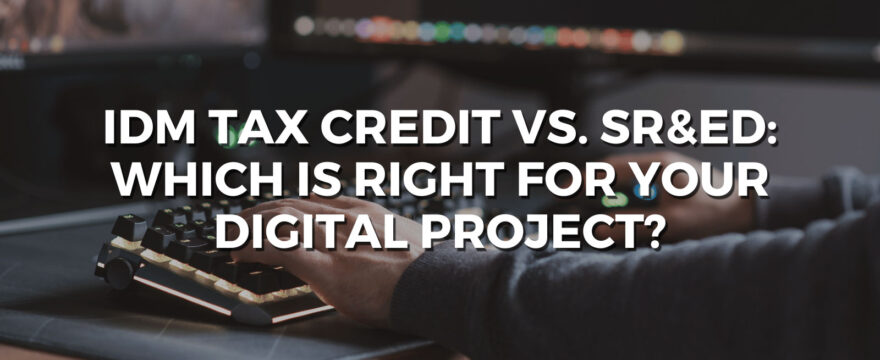
When it comes to digital innovation, government incentives play a vital role in driving creativity, fostering growth, and encouraging businesses to push the boundaries of what’s possible. Among these incentives, the Interactive Digital Media Tax Credit (IDMTC) program is a powerful tool for supporting digital projects in Canada. However, understanding how it compares to other incentives, such as the Scientific Research and Experimental Development (SR&ED) program, is crucial for making informed decisions about your project’s financial strategy. Below, we will compare the SR&ED and IDMTC programs and explain how Easly can enable you to access the cash flow awarded by these tax credits sooner. Keep reading to learn more.
IDMTC: Fueling Digital Creativity
The IDMTC is a provincial initiative designed to support the development of interactive digital media products in Canada. This includes various digital creations, from video games and educational software to mobile apps and virtual reality experiences.
Generally, the IDMTC offers companies a refundable tax credit based on qualifying labour expenditures (eligibility and accrual amounts vary depending on the province you are filing in). This financial boost not only stimulates innovation in the digital sector but also promotes economic growth across Canadian provinces by attracting investments and talent.
SR&ED Program: Encouraging Research and Innovation
On the other hand, the SR&ED program is tailored to encourage research and development (R&D) across a wide variety of industries, including digital innovation. It provides tax incentives to companies that engage in activities aimed at advancing scientific and technological knowledge. This program offers refundable and non-refundable tax credits, depending on your company size, location, and other factors. The SR&ED program is not limited to digital media; it encompasses a broader range of innovations, such as technological advancements, process improvements, and scientific discoveries.
Comparing IDMTC and SR&ED
Qualifying companies can file for both SR&ED and the IDMTC, provided the costs have no overlap. That’s why it is essential to know the differences between these two programs and how you can utilize them to maximize your total government incentives awarded. Below are some general comparisons between SR&ED and IDMTC.
Eligibility
- IDMTC: Specifically targets companies involved in creating interactive digital media products, such as video games, e-learning software, and mobile apps. Eligibility requirements are dependent on the province claimants are filing in.
- SR&ED: Encompasses a broader range of industries and activities that involve scientific or technological advancements, experimentation, and innovation. This is a federal program and is open to any companies within Canada that meet the eligibility criteria.
Scope of Activities
- IDMTC: Primarily focuses on labour expenses related to digital media product development.
- SR&ED: Encompasses a broader spectrum of activities, including labour and materials consumed.
Refundability
- IDMTC: Generally offers a refundable tax credit, meaning you can receive a cash refund even if your tax liability is lower than the credit amount.
- SR&ED: Provides refundable and non-refundable tax credits, depending on factors like your business type.
Project Type
- IDMTC: Ideal for companies engaged in digital media creation, such as game studios, app developers, and e-learning content creators.
- SR&ED: Suitable for various projects, such as experimental development, engineering, scientific research and testing.
Choosing the Right Incentive for Your Project
The decision between IDMTC and SR&ED ultimately depends on the nature of your project, its goals, the type of innovation you’re pursuing, and if your province offers an IDMTC. If your project primarily involves the development of interactive digital media products, such as digital publishing projects, video games or educational apps, the IDMTC could offer a substantial financial boost tailored to your sector.
However, if your project involves broader innovation activities, such as technological advancements, process improvements, or scientific research, the SR&ED program might be the more suitable option. It’s worth noting that some projects might even qualify for both incentives, allowing you to potentially maximize your financial benefits depending on the province and the eligibility criteria. However, expenditures can only be claimed for one or the other program, so it’s worth working with an experienced consultant to determine which projects should be claimed under the different programs in order to maximize your returns.
Overall, both the IDMTC and the SR&ED programs have their merits and foster Canadian innovation. They also share the fact that they are only disbursed once per year after they are claimed with annual taxes. Waiting more than a year from when you begin spending on eligible projects to when you receive your refund can be challenging for a growing business. Easly is here to help!
Learn more about financing your investment tax credits (ITCs)with Easly! See how you can receive an advance on your earned ITCs in as little as two weeks. Easly’s Capital-as-a-Service (CaaS) platform makes it easy to receive the funds needed to continue developing your innovations.
.png)
.png)
.png)
